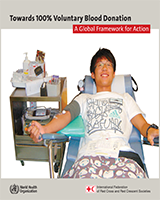All rights reserved. Publications of the World Health Organization can be obtained from WHO Press, World Health Organization, 20 Avenue Appia, 1211 Geneva 27, Switzerland (tel.: +41 22 791 3264; fax: +41 22 791 4857; email: tni.ohw@sredrokoob). Requests for permission to reproduce or translate WHO publications – whether for sale or for noncommercial distribution – should be addressed to WHO Press, at the above address (fax: +41 22 791 4806; email: tni.ohw@snoissimrep).
NCBI Bookshelf. A service of the National Library of Medicine, National Institutes of Health.
Overview
This global framework for action to achieve 100% voluntary blood donation has been developed jointly by the World Health Organization and the International Federation of Red Cross and Red Crescent Societies. It is designed to provide guidance and support to countries seeking to establish effective voluntary blood donor programmes, phase out family/replacement blood donation and eliminate paid donation.
The vision embodied in this framework is the achievement of 100% voluntary non-remunerated blood donation in every country of the world. It is based on the recognition that voluntary non-remunerated blood donors are the foundation of a safe, sustainable blood supply. Without a system based on voluntary unpaid blood donation, particularly regular voluntary donation, no country can provide sufficient blood for all patients who require transfusion.
This document aims to:
- provide information and guidance on the vital role of voluntary blood donors in assuring the availability of stable and sufficient supplies of safe blood for transfusion; and
- propose a series of interlinking strategies and suggestions for concrete action at national and community levels to scale up voluntary blood donor programmes with heightened commitment and support from governments, partners and other stakeholders.
Contents
The development of this publication was supported by Cooperative Agreement U62/CCU024044 from the Department of Health and Human Services/Centers for Disease Control and Prevention (CDC), National Center for HIV, Viral Hepatitis, STD, and TB Prevention (NCHHSTP), Global AIDS Program (GAP). Its contents are solely the responsibility of the authors and do not necessarily represent the official views of CDC.
The designations employed and the presentation of the material in this publication do not imply the expression of any opinion whatsoever on the part of the World Health Organization concerning the legal status of any country, territory, city or area or of its authorities, or concerning the delimitation of its frontiers or boundaries. Dotted lines on maps represent approximate border lines for which there may not yet be full agreement.
The mention of specific companies or of certain manufacturers’ products does not imply that they are endorsed or recommended by the World Health Organization in preference to others of a similar nature that are not mentioned. Errors and omissions excepted, the names of proprietary products are distinguished by initial capital letters.
All reasonable precautions have been taken by the World Health Organization to verify the information contained in this publication. However, the published material is being distributed without warranty of any kind, either expressed or implied. The responsibility for the interpretation and use of the material lies with the reader. In no event shall the World Health Organization be liable for damages arising from its use.
- NLM CatalogRelated NLM Catalog Entries
- Expert Consensus Statement on achieving self-sufficiency in safe blood and blood products, based on voluntary non-remunerated blood donation (VNRBD).[Vox Sang. 2012]Expert Consensus Statement on achieving self-sufficiency in safe blood and blood products, based on voluntary non-remunerated blood donation (VNRBD).WHO Expert Group. Vox Sang. 2012 Nov; 103(4):337-42. Epub 2012 Jun 13.
- Comparison of Volunteer Non-Remunerated Donors and Replacement Donors.[J Nepal Health Res Counc. 2023]Comparison of Volunteer Non-Remunerated Donors and Replacement Donors.Gurung N, Shakya B, Rai G, Shrestha D. J Nepal Health Res Counc. 2023 Jul 20; 20(4):973-976. Epub 2023 Jul 20.
- Review Status of blood transfusion in World Health Organization-Eastern Mediterranean Region (WHO-EMR): Successes and challenges.[Transfus Apher Sci. 2017]Review Status of blood transfusion in World Health Organization-Eastern Mediterranean Region (WHO-EMR): Successes and challenges.Darbandi A, Mashati P, Yami A, Gharehbaghian A, Namini MT, Gharehbaghian A. Transfus Apher Sci. 2017 Jun; 56(3):448-453. Epub 2017 May 8.
- A university - Led initiative to promote voluntary non-remunerated blood donation in a developing country.[Transfus Apher Sci. 2019]A university - Led initiative to promote voluntary non-remunerated blood donation in a developing country.Charles KS, Friday M, Lall D, Harrichan K, De Four M, Guy K, Earle A, Rawlins D, Chantry AD. Transfus Apher Sci. 2019 Oct; 58(5):674-679. Epub 2019 Sep 5.
- Review Altruism and payment in blood donation.[Transfus Sci. 1997]Review Altruism and payment in blood donation.Fernández-Montoya A. Transfus Sci. 1997 Sep; 18(3):379-86.
- Towards 100% Voluntary Blood DonationTowards 100% Voluntary Blood Donation
Your browsing activity is empty.
Activity recording is turned off.
See more...
